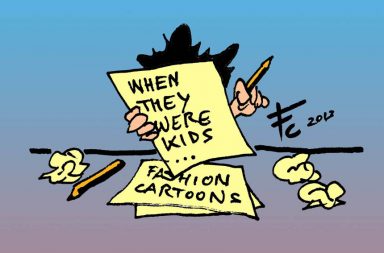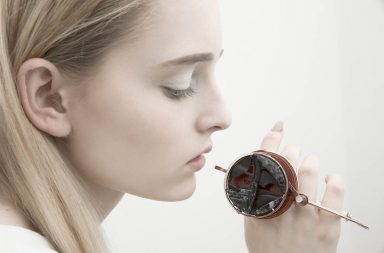In a world of fast fashion, of rapidly changing trends and concepts of design, discovering artists such as the duo of Tesler and Mendelovitch is like a sweet breath of fresh air, a vision of articles made with care and over time, full of meaning and innovation.

We could call them woodworkers, but they’re more than that. In the two years since they started working in the field, they’ve changed the definition of wood as only for furniture. These two young Israeli artists have turned wood into fabric, in this case, for clutches.
The process of ‘slow production’ with which they make each piece, treating and preparing the wood has attracted has turned quite a few heads.
Orli Tesler and Itamar Mendelovitch met while studying Textile Design at university and their interest in innovating, experimenting and pushing the possibilities of wood to the limit has made them stronger.
TESLER (Orli Tesler Rachin):
I was born in Sydney, Australia but moved to Israel with my family in 1992 at the age of 10 years old. My father is Israeli-born and wanted to move back after many years abroad. I attended many schools because I got expelled so much- I was sort of restless and didn’t have much patience for studying so I kept getting in trouble. I finally found a great environment at university when studying Textile design. The studies were dynamic and I had a lot of freedom to experiment and do what I was most interested in which was getting messy. I was initially on a fashion design path but quickly chose textiles as I realized the potential of the textile surface and what could be done with it. Before that, I had worked as an illustrator for clothes brands but found the experience to be a bit constricting as I was fulfilling someone else’s vision and not my own.
MENDELOVITCH (Itamar Mendelovitch):
I was raised in a Kibbutz in northern Israel. I too was not the best student as all my time was spent playing soccer and that’s all I cared about until late in my teens, I got injured and could not play professionally. We had a small carpentry on the Kibbutz which I would visit many times- this was where I learnt how to use woodworking tools and gain knowledge of this profession. I moved to the city and worked for several years as a carpenter at a high-end label where I decided I wanted to create my own things and thus enrolled in Textile Design as I wanted to learn more about materials and what to do with them.

SO CATCHY!: When did you start to work together and why?
T: We became friends very quickly; Itamar is a thoughtful quiet person. Those qualities are very different to my own. We sort of complete each other which makes us good companions and a solid team. Despite our differences we have similar aesthetics and see life in a very similar way.
M: We began to collaborate in our first year at university- we spent a lot of time talking about materials, techniques – what could be done and how. We would go all over the university looking for lecturers that could give us information on the things we wanted to know; fiber science, 3d printing. Ecology versus industry. Weaving, printing and dye methods. If there was someone we knew had the knowledge we were there to ask.
SC!: Why did you choose to work on wooden clutches? How did the idea come up?
T: Wood has been a core working material for both of us. But mainly we had set a sort of goal which is to look for ways where we can create illusions of texture; creating soft surfaces from hard materials and vice versa.
The wood is what inspired the shape of the clutch. It would not be possible if we had worked with leather for instance or any kind of thread or plastic.
M: The clutches were a progression of working on larger objects. We had launched a furniture line from the same textile. We were looking for more applications to work on. The clutches were not intentional-the material incurred the shape. It told us what it wanted to be and we just let it free.
Apart from that, wood has been our core working material ever since we began to collaborate. There is something so naturally beautiful about this material and yet it has been used in the past in very specific ways. We wanted to really try and give wood a new context by challenging the rules and boundaries of the material. No matter how you interfere with it, the effect that wood has on a person in their surroundings is always a very good feeling. With us it is the smell of the wood, the grain and history that makes every piece unique.
SC!: Explain the concept behind your designs…
T: We love optical illusions or anything that makes you look twice and see something different than what you thought perceive it to be at first. This is what we search for when beginning a project and also we are minimalists at heart. It is about strict editing- leaving only the essential lines or components that need to be there and eliminating the rest.
M: Our design is an outcome of our studies in aesthetics integrated with elements of technology and geometry.
SC!: Was it easy to create the first wooden clutch? What kind of challenges did you face?
T: Good design in our opinion starts with a good idea but trial and error are what produces an excellent result. There are no shortcuts unfortunately, the longer you can work on something, the better the outcome.
M: Time is definitely the most difficult challenge- we are expected as designers to launch a new design every six months but this is in fact detrimental to the creative process.
SC!: Can you tell us the process of manufacturing one of your clutches? How long, materials… From the idea to the clutch.
T: Each clutch can take up to 3 days to make. We treat the wood before working it, that needs to settle- then the cutting process, sandpapering and polishing with shellac.
M: Because the process is labor intensive, we make to order. This is to ensure that we maintain a very personalized process. We know where each clutch is going, who it is for. It also helps us to maintain the quality of each piece.

SC!: How do you make them flexible and usable? It seems like a difficult process…
T: The treatment of the wood and the lines that are cut into the material are part of what makes it possible to bend so much and stay strong and durable.
M: It was quite difficult to achieve but the more you push yourself, the better the method gets.
SC!: What other kind of works do you do with wood?
T: We launched a furniture line last year called “Diamond Woods” that are a limited edition of coffee tables and stools from our wooden textile. Now, we are working on a sculpture for an art exhibition here in Israel which is quite challenging as it will be something that we have not attempted to do before- another evolution of the wooden textile technique. Also, we have some new fabricated experiments in progress that we hope will be successful.
M: There is a never-ending pool of ideas to choose from. Time is what we have yet to master!
SC!: What´s your next challenge? Are you going to design other kinds of items in the near future?
T: We will be launching a product very soon that can filter small dust particles which will look different to how it has looked before.
M: We have been working intensively with weaving techniques as well and hope to showcase a new product in that field of textiles. Also, the sculpture is currently giving us a hard time of it, technically speaking- we hope to pull that off very soon as we don’t have a lot of time left..
SC!: Define the client who buys one of your clutches.
T: They are almost always designers themselves or in a related field.
M: It is great to have clients who speak this funny language of design- it feels familiar and there is a mutual respect between us and the client. We are very appreciative of that. Of course, there are those who are not part of the industry which is great too. We enjoy making a clutch for anyone who wants one and is willing to wait the 28 days we require before dispatch.
SC!: What is Israel like for the fashion business? Do you think it would be easier if you lived in London, for example?
T: Maybe a few years ago it would have been necessary for us to move to a more central location but now that everything is so viral we can continue to work here. Tel-Aviv is amazing as far as fashion design and innovation. There are some truly remarkable designers here in many fields that are worth checking out. Innovation is a big part of this society and there are so creative people here that are just superb artists.
M: We may live abroad for a few years for a change of scenery though – it is important to change surroundings once in a while.

SC!: Mention one or two blogs/website you like and find useful…
T: We read the news mostly- current events are what keep us connected to today, tomorrow and yesterday. Some are Israeli and some are in English. I also have some favorites, Gawker is a deliciously snarky website. Also, anything food related is good for me. We also showcase on NJAL and they have wonderful newsletters that are all about the slow fashion movement and ideas on fashion today.
M: I read the news mostly.
SC!: Where do you see yourself next?
T: There are many paths that we plan on taking. They keep changing but the projects don’t. We just want to continue to have the freedom to create what we like without consideration of industry pressure or any specific design niche.
M :I am looking forward to the unknown. I hope the same – to continue to do what we love. It is not something we take for granted.
SC!: Your impossible dream is…
T: To see a world that will slow down a little. I myself am a very fast person in nature but understand the value of stillness and ‘slow cooking’, relaxation and patience. This is really lacking in society although there are many creatives and advocates that are pushing the slow fashion movement which is a wonderful thing.
M: Good things take time, I hope it catches on. In fact I think it is not an impossible dream but rather a dream that is not far.
Photos courtesy of Yotam From, he is a good friend of Tessler and Mendelovitch and also photographs for the Israeli artist Sigalit Landau.
You can pick up one of their clutches at their website.
Translation by Michael Padilla




